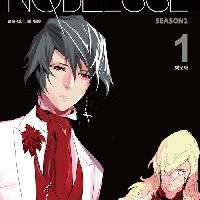Japanese mythology and folklore is full of strange monsters, ghosts, and other supernatural beings. Many of these have roots in Shinto, an ancient Japanese folk religion. Shinto is polytheistic—meaning it has many gods—and tradition holds that all objects and concepts have an associated spirit or god of some type. You may be familiar with the onryo, a long-haired spirit of vengeance that inspired the Ringu and Ju-On films. But did you know that household objects have their own spirits? Here are a few of the odder things you'll find in your journey through Japan's supernatural stories.
Kasa-obake

We're hitting the ground running with a living umbrella. You see, Japanese mythology deals heavily in youkai—"ghosts" or "phantoms" in English. These creatures can be anything from anthropomorphic animals to tsukumogami, or objects that have survived long enough to develop intelligence. From this we get the kasa-obake: a (usually) one-legged, one-eyed, animate umbrella.
Unlike many of the creatures on this list, there are no stories of personal encounters with kasa-obake. Mostly they appear in haunted houses or other supernatural places, as symptoms or minions of a more powerful magical presence. Buddhist fables influenced the development of the kasa-obake legend, portraying these umbrella monsters as one of many spirits of discarded tools. Discard an umbrella needlessly, and it might come back to menace you with a long tongue and a single unblinking eye. Kasa-obake are common in media concerning the supernatural, such as Rosario+Vampire and even Azumanga Daioh.
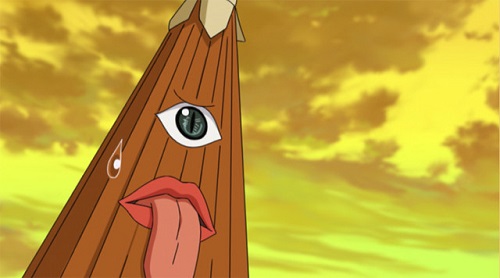

Top: Kozo, a kasa-obake from Rosario+Vampire
Bottom: Azumanga Daioh's Osaka dressed in a kasa-obake costume
Kappa
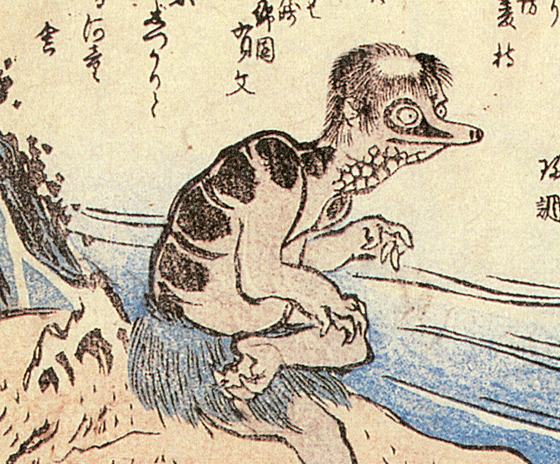
The kappa is an odd, turtle-like creature that lives in rivers. In most appearances they are antagonistic toward humans, playing pranks at best and eating or kidnapping children at worst. A kappa's most distinctive feature is the bowl-shaped area on the top of its head; the kappa must keep this filled with water or be paralyzed or killed, depending on the legend. Luckily, kappa are notoriously polite and can easily be tricked into bowing and spilling their water. Though the kappa can be mischievous or dangerous, refilling a dry kappa's bowl will make it loyal to you—and a captured kappa is a hard worker. You can also persuade one to go away if you give it a cucumber with your name carved in it...for some reason.

An Amanto, or alien from the series Gintama, that happens to look like a kappa
Kappa have been portrayed as horse thieves, vampires, and sexual predators, and they are often used to warn children away from playing near rivers. They are common in anime, but are usually less violent pranksters compared to their historically carnivorous identity. The Pokémon Ludicolo is based on the kappa, one of many Pokémon inspired by Japanese mythology. An anime film, Summer Days with Coo, has a benevolent kappa as a child's pet. Arakawa Under the Bridge also has a kappa character—or at least a man dressed as one.
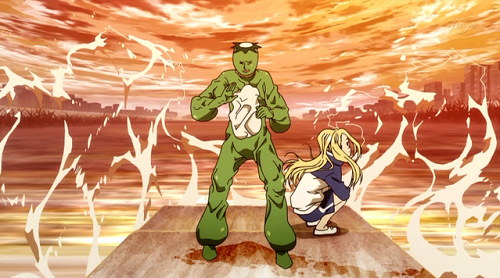
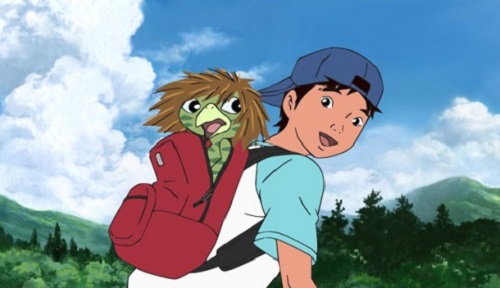
Top: The village chief from Arakawa Under the Bridge, dressed as a kappa
Bottom: The friendly kappa from Summer Days with Coo
Shirime

There's not a lot of literature out there on this guy, but if you find yourself researching strange Japanese creatures, you're guaranteed to read about him at some point. Why? Here's a hint: literally translated, its name means "buttocks eye."
The only surviving legend about the shirime tells of a lone samurai walking to Kyoto late one evening. Depending on who's telling the story, a voice calls to the samurai from the bushes or a man approaches him. When the samurai asks what the stranger wants, it turns around and moons him—revealing a massive eye where its anus should be.
Nobody knows for sure who invented the shirime, but it's generally considered to be a rather crass variant of the noppera-bo—a type of youkai that gets your attention and then reveals that it has no face, just for fun. For obvious reasons, the shirime is rare in mainstream media, but it can be found. Perhaps its most notable appearance is during the ghost parade scene in Studio Ghibli's Pom Poko, in which a mischievous shirime turns up in a garbage can.
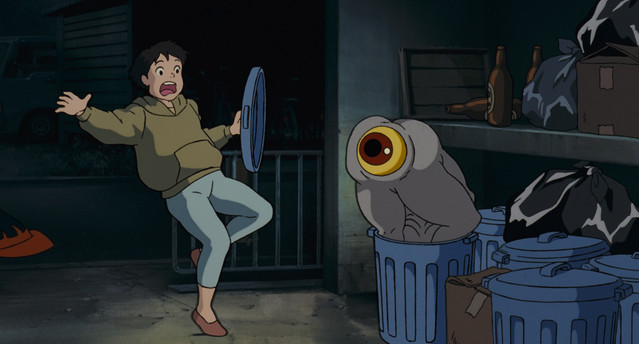
A rare shirime in Pom Poko
Rokurokubi

Rokurokubi are youkai that can manipulate their heads independently of their bodies. There are two types: those whose heads can detach and fly around, and those whose necks can extend. The former type was the first to appear, and generally flew around at night to drink blood and prey on humans. The neck-extending type dates from later, Edo-era legends in the 1600s, and were briefly fodder for freak shows and quack science revolving around people with unusually long necks.
Decapitation-type rokurokubi originate from China and appear in folklore throughout eastern and southeastern Asia. These are primarily mischievous or malevolent demons, though tales from China's Three Kingdoms era also tell of foreign tribes of rokurokubi, similar to Western European legends of primitive races with odd anatomies. They are common in Japanese media dealing with youkai, notably in the Pokémon-esque Youkai Watch and in Pom Poko. Certain characters also demonstrate powers consistent with extending-type rokurokubi, generally inhuman villains such as Orochimaru of Naruto.


Top: A rokurokubi and a kasa-obake from Youkai Watch
Bottom: Orochimaru's Slithering Snake Mode
Zashiki warashi

Zashiki warashi is a portmanteau of old words for "sitting room" and "child". It is the ghost of a child in traditional Japanese dress, visible only to the owners of the house it haunts. It is a harmless being, content to play pranks like flipping pillows and making noise. Much like a human child, caring for the zashiki warashi is generally encouraged; it is a luck spirit that brings fortune to the houses that welcome it. Neglect it or drive it away, and your fortunes will fall into ruin.
Zashiki warashi are benevolent if treated well, teaching children songs and games and keeping childless adults company. Their legends have given rise to folk superstitions about building and moving into new houses, including putting coins and food out for the ghost children. They have been depicted traditionally in anime, such as the nameless ghost girl in xxxHOLIC, but their nature can vary. The zashiki warashi of Mononoke are the ghosts of prostitutes' children that were slaughtered in a brothel.


Top: A zashiki warashi in Mononoke
Bottom: The zashiki warashi from xxxHOLIC
Kamaitachi

Kamaitachi is Japanese for "sickle weasel", and it sounds like a Pokémon designed by Satan. It is a weasel that lives in a dust devil, riding the wind and using razor-sharp blades to cut any who draw too near. There is no consensus on what these creatures do or are meant to represent. In some regions they are the spirits of cold whirlwinds; in others, they are another form of tsukumogami, the vengeful revenants of discarded sickles. The most entertaining story is that they travel in threes: one to knock travelers down, another to cut them up, and a third to immediately heal the victim. This all happens in the time it takes to trip, fall, and get back up again. Though tales of wind-riding spirits are not uncommon in Japan, the kamaitachi has slowly become conflated with all of them.

Temari's kamaitachi from Naruto
Kamaitachi are one of the rarer creatures outside of Japan, but they do appear in anime. A pink guardian spirit patterned after classical depictions appeared in Shaman King, and a pair of kamaitachi in Ushio to Tora are cast as angry youkai tired of being forced to move by human construction. Naruto's Temari can summon a kamaitachi spirit to aide her in battle.


Top: Shaman King's kamaitachi
Bottom: Juro, a kamaitachi from Ushio to Tora
Bake-kujira

Bake-kujira means "ghost whale," and that's exactly what it is. It comes from a regional legend in Shimane Prefecture in western Japan, which tells of a mysterious whale skeleton that swam close to shore one day. Even stranger, the bake-kujira was surrounded by countless otherworldly birds and fish. A fisherman tried to harpoon it, and predictably failed—have you tried harpooning a skeleton lately? Before anyone could try again, the bake-kujira swam away—devoid of flesh, but apparently alive and unharmed.
There isn't much else to say about the bake-kujira; the centuries-old story is all we have of it, and it appears almost nowhere else in Japanese mythology. The significance of whales in the lore of Japanese fishing villages is undeniable, however; whales were known to travel among large groups of marine life, and the whales themselves are known to have saved starving villages with their massive, tasty bodies. Their reputation as benevolent, aloof deities is well documented.
A popular depiction of the bake-kujira comes from Shigeru Mizuki's GeGeGe no Kitarou; the popular manga and the six anime series it inspired are largely responsible for modern conceptions of youkai and other monsters. A brief media circus also flared up about 30 years ago around the discovery of a whale skeleton floating in shallow waters; imagine a sighting of the Loch Ness Monster and you have the rough equivalent.

The bake-kujira as depicted in the Eastern-themed card game Legend of the Five Rings
And Many More...
These are just a few of the weird monsters that inhabit Japan's supernatural world. Many of them are legendary creatures that represent powerful emotions or natural phenomena, such as the bake-kujira. Others are metaphorical explanations of various aspects of human culture, such as the kasa-obake. As the mythologies developed and merged, new monsters and stories emerged to create an internal consistency to the spirit realm, rather than to explain everyday occurrences. The hikeshibaba, for instance, is an old woman's ghost that exists solely to blow out lanterns. Youkai often work better in the dark, after all. Regardless of their purpose, a culture's monsters and myths are stories its people tell to contextualize their experiences. Though they can eventually take on lives of their own, even the strangest creatures can speak volumes about those who create them.

